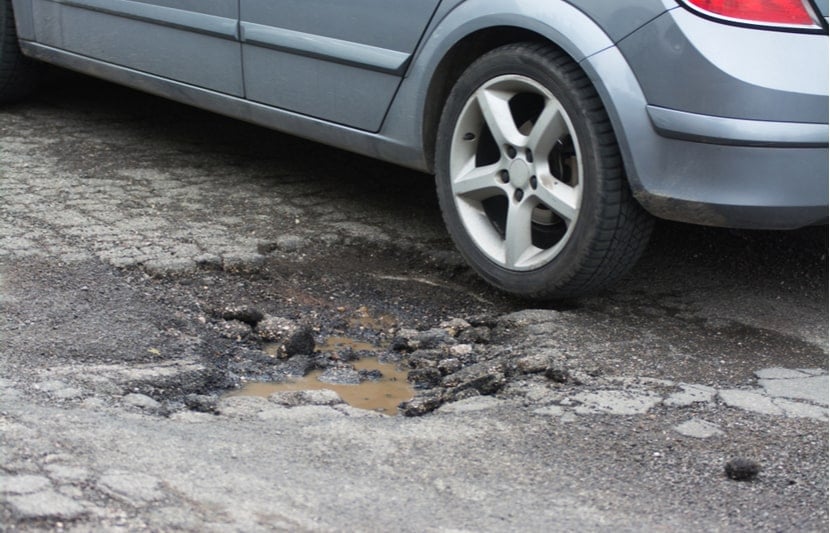Potholes. The motorists enemy. We've all been there. You're driving along and you hear an almighty bang and hope that you haven't got a flat tyre.
Sometimes you can escape unscathed. But if your car does get damaged by a pothole, you can claim for damage through your local council.
If you can't claim through your local council, you could claim for damage on your car insurance - but your premiums could rise in future.
In this guide, we'll look at how to claim for pothole damage. We'll also look at what counts as a pothole (yeah - not all holes are potholes) and what causes them.

What is a pothole?
A pothole is a hole in the road surface where the tarmac has cracked and worn away.
But councils have a stricter definition. On the hole (pardon the pun), councils usually classify a pothole as 4 cm deep and between 20 -30 cm wide. Every council’s definition varies, but most use these measurements to determine potholes.
If the hole has smaller dimensions than this it's probably classified as a ‘carriageway defect’, which is the same thing, just under a different name.
Unfortunately, you can't claim from your council if your car is damaged by a carriageway defect, but we'll get into claiming in more detail later in the guide.
What causes potholes to appear in the road?
Bad weather usually causes potholes. They usually start appearing in the winter months.
Water seeps into cracks on the road surface. When this water freezes, it expands causing cracks in the tarmac. As more cars drive over it, the tarmac gets even more damaged and can cause a pothole.
Why is the UK’s pothole problem so bad?
Potholes could be getting worse in the UK because of the amount of severe rain and stormy weather we’re getting. It might also be because there’s more traffic on the road.
There's also other factors to consider, for example, in 2022 there was a shortage of bitumen. This is a key ingredient of tarmac. The shortage caused more delays to pothole repairs which could knock on to future years.
What is the government doing to sort the UK's pothole problem?
In December 2024, local councils were given £1.6 billion to fix potholes in England. According to the government, the fund is enough to fix the equivalent of over 7 million extra potholes from 2025 to 2026.
The government works out what to allocate to each council, then the council can decide which roads are the most in need of repair and deliver 'immediate fixes'. Some of the allocations include:
-
Over £327 million for local authorities in North West, North East and Yorkshire and Humber
-
Over £372 million for local authorities in East Midlands and West Midlands
-
Over £244 million for local authorities in the East of England
-
Over £322 million for local authorities in the South East and London
-
Over £300 million for local authorities in the South West
Prime Minister, Sir Keir Starmer, said:
"Broken roads can risk lives and cost families hundreds if not thousands of pounds in repairs. That’s a cost that can easily be avoided by investing properly in our roads."
In Wales, the Welsh government has spent more than £81 million resurfacing around 321km of roads. But since 31 January 2025, there's an extra £25 million to prevent around 30,000 road defects.
The Welsh government predicts that by the end of the Senedd term (5 years), £118 million will have been spent to repair more than 500km of road defects and potholes.
Cabinet Secretary for Transport and North Wales said:
"It is crucial that we fix our roads. I’m delighted to be announcing a further £25m of funding to help support a comprehensive refurbishment programme to improve the future resilience of our strategic roads network and prevent potholes.
"We are already working hard to fill potholes and renew, as fast as possible, key sections of our road network, but this additional funding will help to accelerate this work."
Scottish councils have an additional £1billion in funding for councils for 2025 to 2026. First Minister John Swinney said:
"The Scottish government has adequately and fully funded local government to make sure these issues, such as potholes, can be tackled in our local communities so that we can invest in our public infrastructure and meet the needs of the public."
In 2024, the infrastructure minister for Norther Ireland announced an additional £1 million investment in road maintenance, specifically addressing the pothole problem.
Minister John O’Dowd said:
“This £1million investment is the start of addressing the problem, it’s a statement of intent that I will seek out the investment to improve our road networks for motorists and cyclists.
"This is a positive announcement which will have a real impact on road users. I will continue to press for vital funding to ensure our roads are maintained to a high standard.”
"Although the harsh winter months are almost behind us, potholes are still proving problematic for drivers across the UK. That’s as our latest data reveals how roads are seemingly getting worse, with around 1 million potholes reported last year - a 24% increase compared to 2020.
“There’s no denying that the UK has a pothole problem, and the government has dedicated more funding as a result. But for some drivers this isn’t enough. Especially if they live in high risk areas, where wet and colder weather means problems are more likely to arise.”
What our motor insurance expert says

Who's responsible for pothole damage to my car?
Your local council is responsible for pothole damage, so you should always go to your local council first before claiming on your car insurance. They have a responsibility to maintain roads in their area.
But roads that cross several authority areas, such as motorways and A-roads, come under the charge of:
- England: Highways England
- Northern Ireland: Department for Infrastructure
- Scotland: Transport Scotland
- Wales: Traffic Wales
If your car is damaged as a result of running over a pothole, your local authority or one of the 4 national authorities could be liable. But if your car is damaged due to other debris on the road, you aren’t entitled to compensation. For this, you either need to pay for the damage yourself or claim on your car insurance policy.
How to claim for pothole damage
To make a successful pothole claim, you need to show evidence of pothole damage to your car. Here’s what you need to do:
- Check the damage caused by the pothole
- Gather evidence
- Report the pothole
- Get a mechanic to confirm pothole damage and get repair quotes
- Submit your pothole claim
“If your car is damaged due to a pothole, you should always try to reclaim the cost of damage through the council first. That’s because pothole repairs are their responsibility. When making a claim, make sure to take pictures or videos for evidence and be as detailed as you can.
“You should share information about where the pothole was, the time of day it happened and the damage it caused your car. And if the local council won’t compensate for damages, you could also make a claim through your car insurance. But be wary that this could result in a higher premium the following year, so always try the council first.”
What our motor insurance expert says

1. Check the damage caused by the pothole
As soon as you're aware that a pothole may have damaged your car, find a safe place to pull over. Check if there’s any visible pothole damage to your wheels and tyres. While you’re driving you also need check:
- Whether the car is making any vibrations
- How the steering feels
- Whether the car is veering to one side
If there are any problems, get your car to a garage or tyre centre as soon as possible.
2. Gather evidence
You need to show the local authority pictures of the pothole. If you’re returning after the incident to take photos, bring a measuring tape and use that to show its size. If that’s not an option, placing an everyday object you have like a shoe or bag can give a good indication of scale. It’s also important to make a note of:
- The date and time of the incident
- Any witnesses and their contact details
- The location of the pothole on the road
- The damage to your car
- If you visit a garage and they find more damage
3. Report the pothole
Let the right people know about the pothole. For local roads, B roads and minor A roads that’s likely to be the local authority. To find the right council, use the report a pothole tool on the government website.
For more major roads you have to report it to the relevant national authority.
Even if you don’t make a claim or your car isn’t damaged you should still report the pothole to your council straight away. It could help protect other drivers from damaging their car.
4. Get a mechanic to confirm pothole damage and get repair quotes
Ask the mechanic to confirm the cause of the damage in writing. You need this to be able to make your pothole claim from the local authority. It’s also worth getting quotes from at least 3 garages. Keep a record of each and go with the cheapest. Showing willingness to keep repair costs down could help your pothole claim.
5. Submit your pothole claim
When you’re ready to claim for pothole damage, contact the local authority you reported the pothole to.
Make it clear that you’re looking to make a claim for pothole compensation and pass on:
- A full description of the incident
- When and where it happened
- What you’ve done since to address the damage to your car
Don’t forget to include:
- Copies of photos
- Witness details
- Confirmation of pothole damage from the mechanic
- Quotes
- Repairs for damage
- Any other details that could help your claim
Your right to pothole compensation has limits. You need to prove that the local authority failed in its duty to maintain the road, in accordance with Section 58 of the Highways Act 1980.
What happens after I've made a pothole claim?
The local authority is obligated to respond to any claim lodged with them within 30 days. If they don’t, contact them again via the complaints department.
You'll usually get one of these responses:
- The authority accepts your claim and covers all your repair expenses. It probably won’t stretch to additional expenses such as alternative transport.
- The authority offers a partial settlement.
- The authority rejects the claim in its entirety.
If the local authority offers a partial settlement, you can give them a counter offer.
Reaffirm the costs you’ve incurred directly as a result of the incident, and show that you’ve shopped around for the cheapest repairs.
Some claims could take months to resolve. You might also need to be persistent if you’re only offered a partial settlement or you think your claim has been incorrectly rejected.
What if my pothole claim is rejected?
Your claim for pothole damage is likely to be rejected if:
-
It was actually the result of debris on the road
-
If the pit in the road wasn't large enough to be a pothole
If your pothole claim is rejected, you have a few options. Either:
- Accept the rejection
- Take the authority to small claims court
- Claim on your car insurance policy
- If the damage to your car is little more than a burst tyre, you could accept the rejection and pay for repairs yourself
If the pothole damaged or destroyed your catalytic convertor, the costs involved are likely to be high enough to pursue the claim further.
Taking the authority to small claims court is an option, but it's not cheap. If you decide to go down this route, it's worth getting independent legal advice.
You could put in a Freedom of Information Act request to establish whether the council actually inspected the site. They’re required to do so, but might not have.
If the court route doesn’t appeal – and it can be pricey if you use a lawyer and lose – you could claim on your car insurance, where you could then get the damage repaired at an approved garage. Your insurer might consider this an ‘at-fault’ claim, so it could impact your no-claims discount and your future insurance costs.


